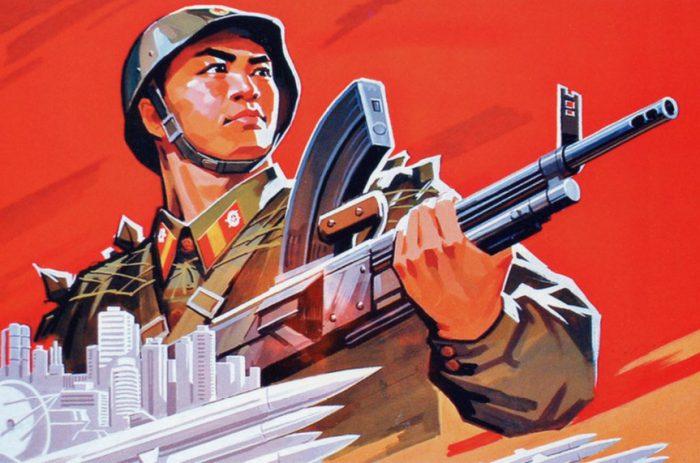Walking the byungjin line: North Korea in the Eurasian century
Posted By William Rooks on June 12, 2019 @ 11:00

US President Donald Trump isn’t concerned by North Korean leader Kim Jong-un’s latest tirade of missile tests [1] and crude insults [2]—but he’s not in the firing line. Since 2017, several North Korean test missiles have flown over Japan. Unsurprisingly, Japanese Prime Minister Shinzo Abe has called [3] for ‘concrete’ action over ‘talks for the sake of talks’, but Trump still believes [4] that a deal with Kim is on the horizon.
North Korea’s attitude towards disarmament has been apparent since March 2013 [5], when the newly minted supreme leader announced his ‘byungjin’ (‘parallel development’) policy. The policy, also known as the ‘byungjin line’, advances simultaneous economic and nuclear-weapons development. It builds on the ruling family’s principles of statesmanship—a reference to Kim Il-sung’s revolutionary slogan [5] of ‘a gun in one hand, and a hammer and sickle in the other’. The byungjin policy was an opportunity for Kim Jong-un to distinguish his own legacy while ensuring the continuation of his family’s rule.
Since that announcement, US policymakers have used the byungjin policy to design and implement effective international sanctions to deter North Korea’s development of nuclear weapons. In 2015, US Secretary of State John Kerry said [6], ‘North Korea needs to recognise that it will not succeed in developing its economy or breaking out of diplomatic isolation if it continues to reject denuclearisation.’
Kerry’s message is reflective of a broader dichotomy underpinning US–DRPK relations (and to a lesser extent the DPRK’s relations with the rest of the world): that North Korea can have nuclear weapons or international trade—but not both. Yet the trade-off between weapons and trade has been inconsistently enforced, and the North Korean nuclear weapons program has accelerated as a result. In 2016, former US director of national intelligence Jim Clapper admitted [7] that getting North Korea to give up its nuclear weapons was ‘probably a lost cause’.
Chinese President Xi Jinping’s Belt and Road Initiative received mixed reactions when it was announced in 2013. The ambitious program promised to inject US$1 trillion across Eurasia through infrastructure projects designed to establish and stimulate regional trade routes. China says [8] the BRI is ‘based on extensive consultation and its benefits will be shared by us all’. Australian commentators shrewdly labelled [9] it ‘a geopolitical and geo-economic agenda to enhance China’s global power and the legitimacy of the Chinese Communist Party’. Despite recent ‘open, green and clean’ proclamations [10], Australia, Japan and the United States remain sceptical [11] of the initiative.
Just over a year ago [12], I reported that trade among revisionist military powers along China’s proposed ‘Silk Road Economic Belt’ with Iran and Russia had surged, and this trend continued into 2018.
Trade between Iran and China was expected [13] to grow by around 12% and reach US$42 billion by the end of 2018. Meanwhile, trade between Russia and China reportedly [14] grew by almost 30% and reached US$107 billion over the year.
The notable exception was North Korea, whose trade with China officially [15] shrunk by 51% in 2018. This figure is disputable [16], however, as persistent allegations [17] of smuggling in the Yellow Sea continue to undermine the credibility of Chinese self-reporting.
If North Korea has signalled [18] a changing focus [19] from the ‘gun’ to the ‘hammer and sickle’, then the byungjin policy needs to remain a key reference point for US policymakers. North Korea attended China’s Belt and Road Summit in May 2017, and the Silk Road Economic Belt could be one of Kim’s most attractive economic opportunities. It’s not unreasonable to suggest that North Korean participation could have been considered [20] as early as March 2018, and the idea has still gained some traction [21] in 2019. This would give China greater leverage over North Korea, at the expense of Western interests, which would reduce the relative magnitude and absolute effectiveness of economic sanctions. And it’s not yet clear how China, an authoritarian revisionist state and aspiring hegemon, would use its increased leverage over Russia, Iran and North Korea.
It’s in the West’s interests to better understand Kim’s thresholds for entering negotiations over nuclear disarmament. Strategies [22] of nuclear ‘latency’ and ‘hedging’ are both potential compromises that would bring North Korea closer to denuclearisation and improve regional stability. Kim’s closing remarks after the Hanoi summit with Trump confirmed [23] that this middle ground remains unexplored.
Washington’s relations with military powers along the Silk Road Economic Belt are deteriorating. The trade war with China is worsening [24], security tensions between the US and Iran are simmering [25], and arms sales [26] to Turkey are the latest battleground in US–Russia relations. In this regard, the major concerns outlined in the 2018 US national defence strategy [27] have become something of a self-fulfilling prophecy: the document focuses on great-power conflict and explicitly targets China, Russia, Iran and North Korea.
The byungjin policy remains a useful tool for dissecting North Korean bilateral and multilateral relations as Kim pivots between nuclear weapons and economic development. Such tools will be increasingly necessary as Eurasian relations become more complex. Western governments should recognise North Korea’s desire to carry both the gun and the hammer and sickle and make policies that account for it.
Article printed from The Strategist: https://aspistrategist.ru
URL to article: /walking-the-byungjin-line-north-korea-in-the-eurasian-century/
URLs in this post:
[1] missile tests: https://www.nytimes.com/2019/05/03/world/asia/north-korea-missile.html
[2] crude insults: https://www.smh.com.au/world/asia/north-korea-calls-joe-biden-an-imbecile-and-fool-of-low-iq-20190523-p51q8x.html
[3] called: https://www.japantimes.co.jp/news/2018/03/08/national/politics-diplomacy/abe-urges-caution-north-korea-talks/#.XPCoDqp--Ul
[4] believes: https://www.washingtonpost.com/politics/trump-denies-north-korea-launched-ballistic-missiles-contradicting-japan/2019/05/27/3b02431a-7e38-11e9-8bb7-0fc796cf2ec0_story.html?utm_term=.a63ba8930df6
[5] March 2013: https://www.globalsecurity.org/military/world/dprk/byungjin.htm
[6] said: https://thediplomat.com/2015/05/us-china-to-jointly-pressure-north-korea-over-nuclear-program/
[7] admitted: https://thediplomat.com/2016/12/former-north-korean-diplomat-denuclearization-not-likely/
[8] says: http://www.xinhuanet.com/english/2017-05/14/c_136282982.htm
[9] labelled: https://www.lowyinstitute.org/the-interpreter/bri
[10] proclamations: https://www.bloomberg.com/news/articles/2019-04-28/xi-jinping-s-wins-and-losses-at-his-second-belt-and-road-forum
[11] sceptical: http://www.abc.net.au/news/2017-10-22/australian-concerns-over-beijing-one-belt-one-road-trade-bid/9074602
[12] year ago: /bandits-silk-road-implications-eurasian-cooperation/
[13] expected: http://www.iran-daily.com/News/231220.html
[14] reportedly: https://www.rt.com/business/448783-russia-china-trade-turnover/
[15] officially: https://www.cnbc.com/2019/01/23/reuters-america-chinas-trade-with-north-korea-falls-51-pct-in-2018.html
[16] disputable: https://www.nbcnews.com/news/north-korea/china-eases-economic-pressure-north-korea-undercutting-trump-admin-n906166
[17] allegations: https://asia.nikkei.com/Spotlight/N-Korea-at-crossroads/China-North-Korea-border-trade-thrives-again-despite-sanctions
[18] signalled: https://www.cnbc.com/2019/02/13/north-korea-may-choose-to-follow-vietnams-economic-model.html
[19] changing focus: https://www.cnbc.com/2018/06/11/how-kim-jong-un-wants-to-develop-his-economy-and-secure-his-regime.html
[20] considered: https://asia.nikkei.com/Features/China-up-close/Kim-Jong-Un-brings-Xi-back-to-table-ahead-of-Trump-meeting
[21] gained some traction: https://www.cnbc.com/2019/01/11/what-north-korea-really-wants-from-china-is-membership-in-the-belt-and-road.html
[22] Strategies: https://www.wilsoncenter.org/publication/exploring-nuclear-latency
[23] confirmed: https://www.washingtonpost.com/opinions/global-opinions/going-big-on-north-korea-failed-trump-should-go-small/2019/03/14/1c47aeee-442f-11e9-8aab-95b8d80a1e4f_story.html?noredirect=on&utm_term=.4eac45238202
[24] worsening: https://www.bloomberg.com/news/articles/2018-06-21/game-theory-explains-why-the-u-s-china-trade-spat-is-worsening
[25] simmering: https://www.theguardian.com/us-news/2019/may/22/us-troop-increase-pentagon-middle-east-iran
[26] arms sales: https://www.aljazeera.com/news/2019/05/russia-condemns-ultimatum-turkey-400-missile-deal-190522144753344.html
[27] national defence strategy: https://www.defense.gov/Portals/1/Documents/pubs/2018-National-Defense-Strategy-Summary.pdf
Click here to print.